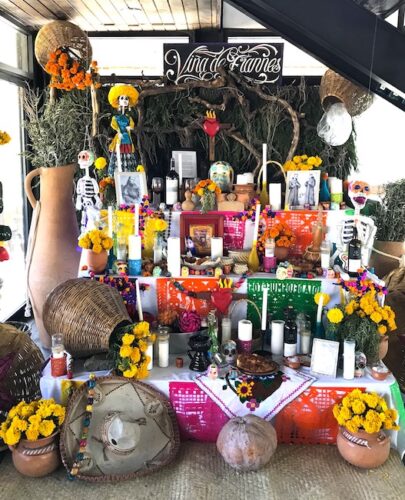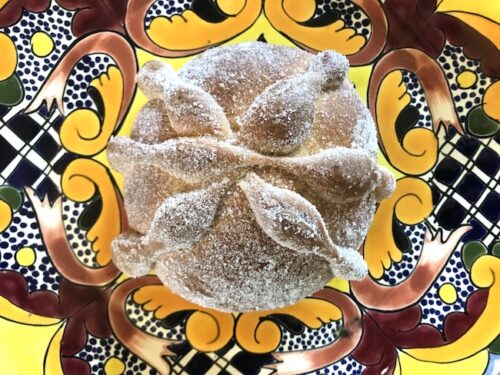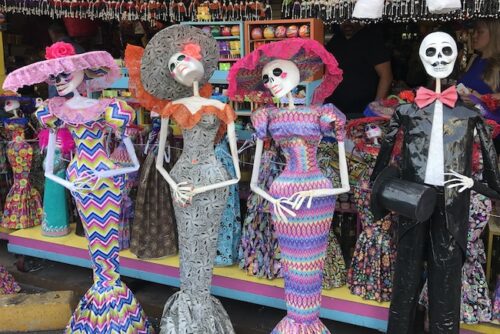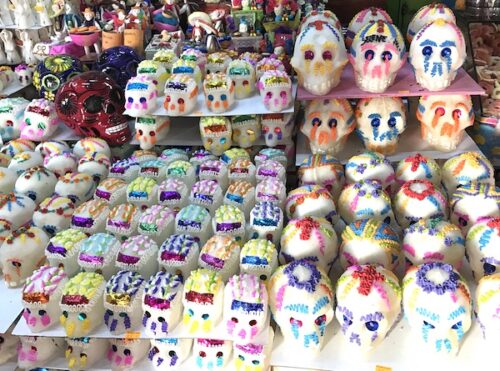Día de los Muertos, or Day of the Dead, is a Mexican holiday celebrated on the 1st and 2nd of November. It’s a happy and festive holiday that celebrates the lives of family and friends who are deceased. The belief is that the deceased come back to visit the world of the living on Día de los Muertos. Decorations and celebrations are focused on guiding and welcoming back the deceased. It’s a happy holiday because the living are rejoicing that the deceased have come back to spend time with them. It’s believed that while you can be sad all year round that your loved ones have departed from this world, during this holiday when the deceased are coming back to be with you, you should be happy. The specific celebrations of Día de los Muertos vary around the country, but here are some of the common traditions of the holiday.
 Altars
Altars
One of the most important traditions is to make colorful ofrendas—altars with offerings—at home. The altars are adorned with photos of deceased loved ones, plenty of candles to light the way, and lots of cempasúchil (marigolds), often called flor de muerto, which attract the souls to the altar. Favorite foods and drinks of the deceased are placed on the altar in addition to pan de muerto (bread of the dead), and calaveras, small sugar skulls that are colorfully and ornately adorned (generally used as decoration only and not to be eaten).
 Food
Food
Food plays an important part of the festivities both for the living and departed. Favorite foods of the deceased are set out on altars to nourish them after their long journey back to the world of the living. Pan de muerto, a sweet bread with bone-shaped decorations on top, is perhaps the most popular treat during Día de los Muertos. Tamales are commonly eaten and and masa-based drinks like atole and champurrado are consumed.
 Traditions & Celebrations
Traditions & Celebrations
In addition to making altars at home, people go to the cemetery and decorate the graves of loved ones. They sing songs and tell stories about the departed. In some areas of Mexico, people dress up as skeletons and ghosts and have small parades. In some places it’s common practice to write funny short rhyming poems called calaveras literarias written about friends, family, and famous figures—both living and dead.
 How You Can Celebrate
How You Can Celebrate
You can build an altar in your own home to celebrate your beloved deceased. It doesn’t have to be fancy. Some photos and candles will suffice. Mexican markets are filled with sugar skulls, marigolds, and skeletons this time of year. If you can’t make it to a market in Mexico, check out your local Mexican market (such as Northgate in San Diego). Sometimes the bakery section will even have pan de muerto. Most places around Southern California have Día de los Muertos celebrations. San Diego has a number of celebrations (see a 2023 list here) including the popular festivities in Old Town. Los Angeles also has a number of celebrations (see the 2023 events here). In Tijuana, El Mictlán de Tijuana is a farm off of Blvd 2000 that grows cempasúchil (marigolds) and visitors can walk through the fields for photos and purchase flowers on site until Nov. 5. If you’re looking for a sweet and lighthearted way to learn more about the holiday, watch the Pixar movie Coco.
